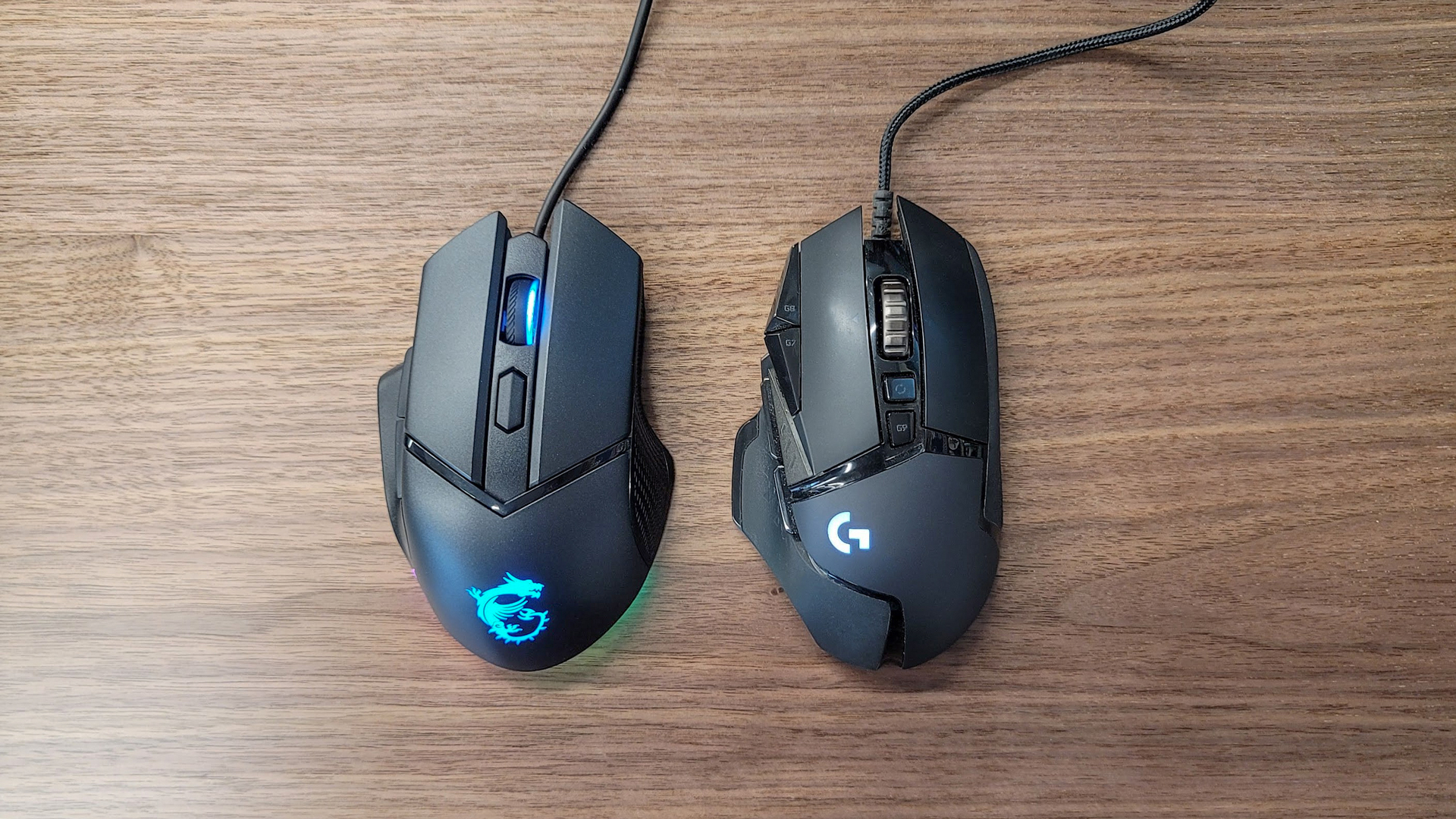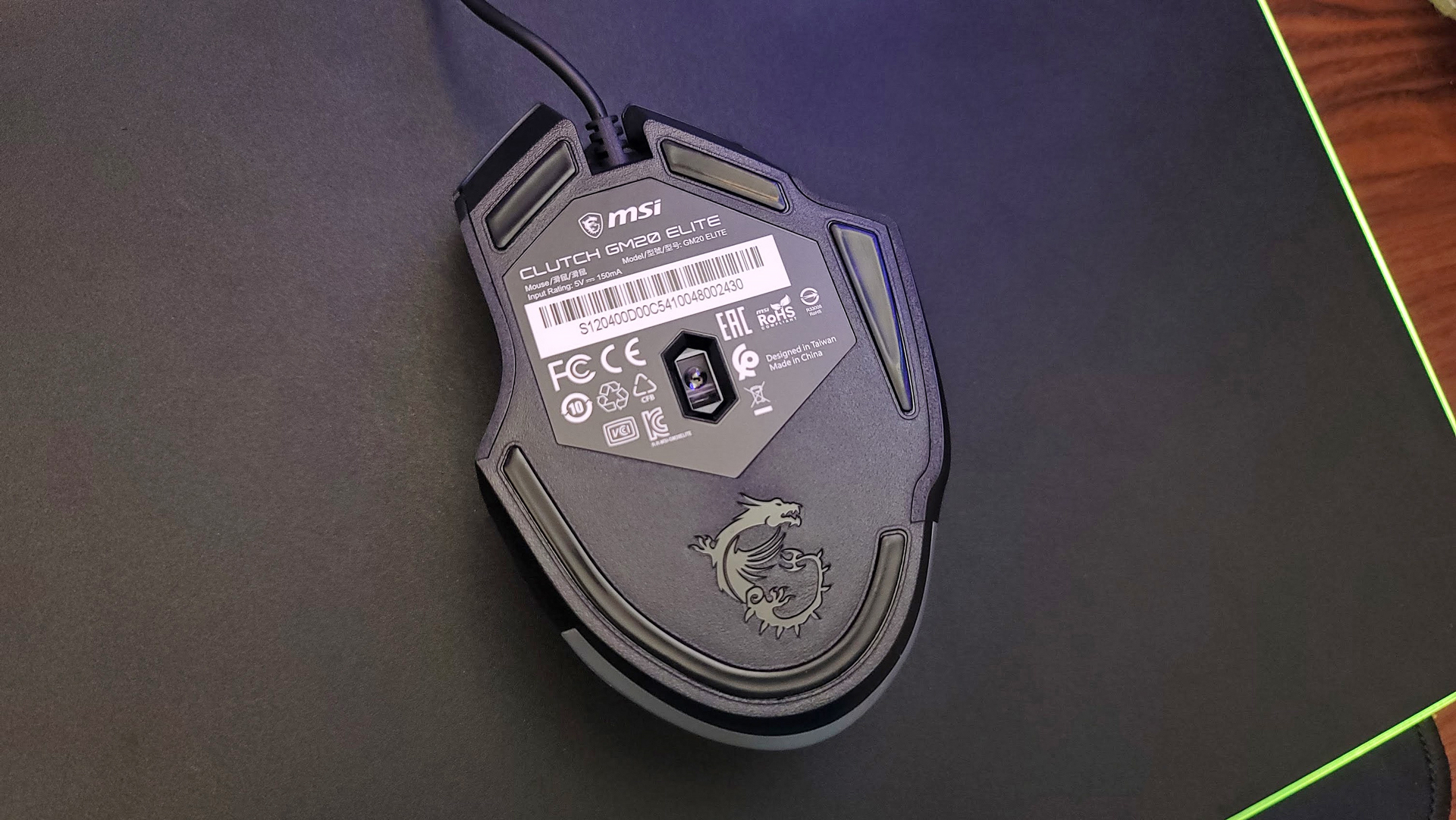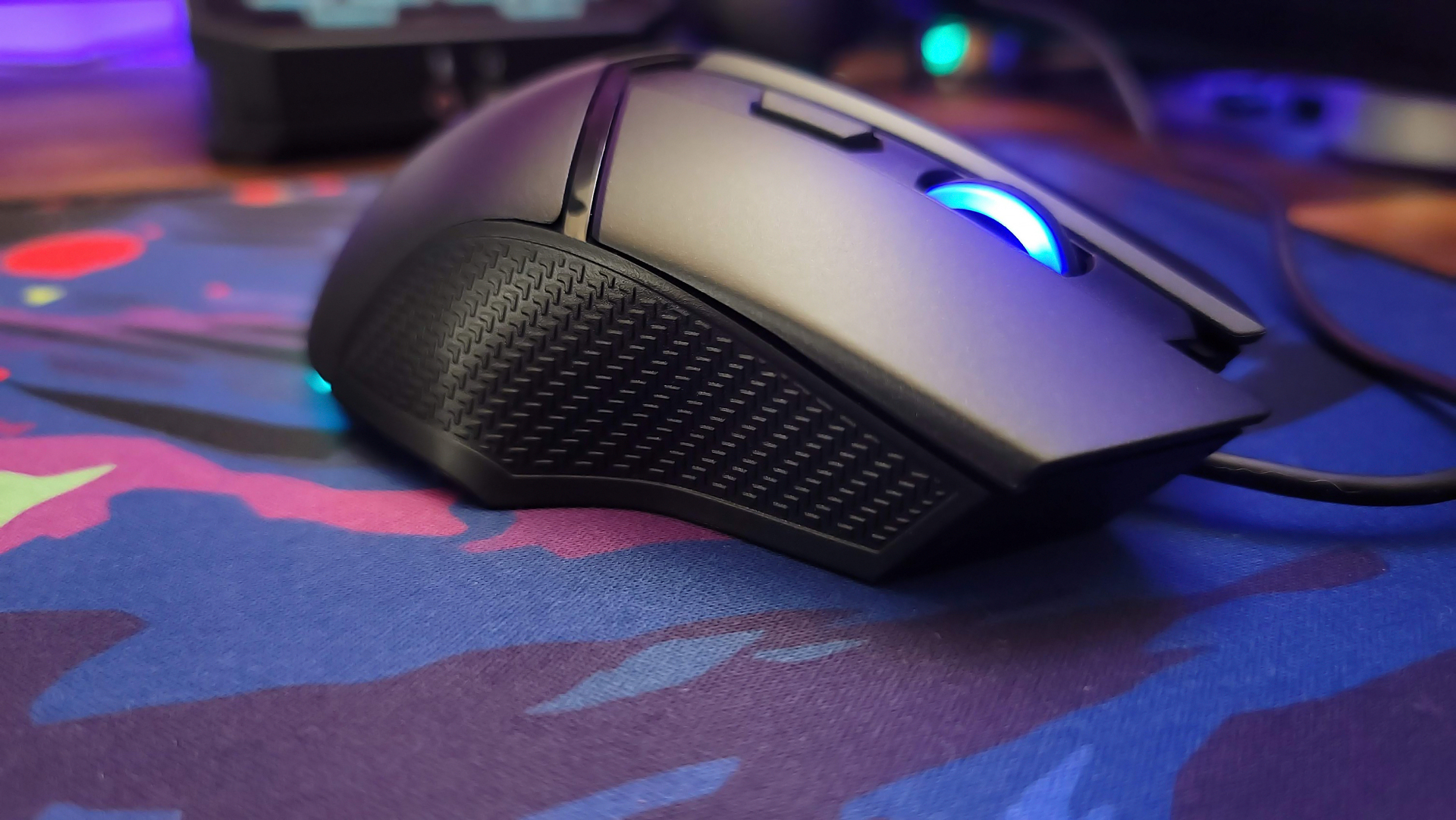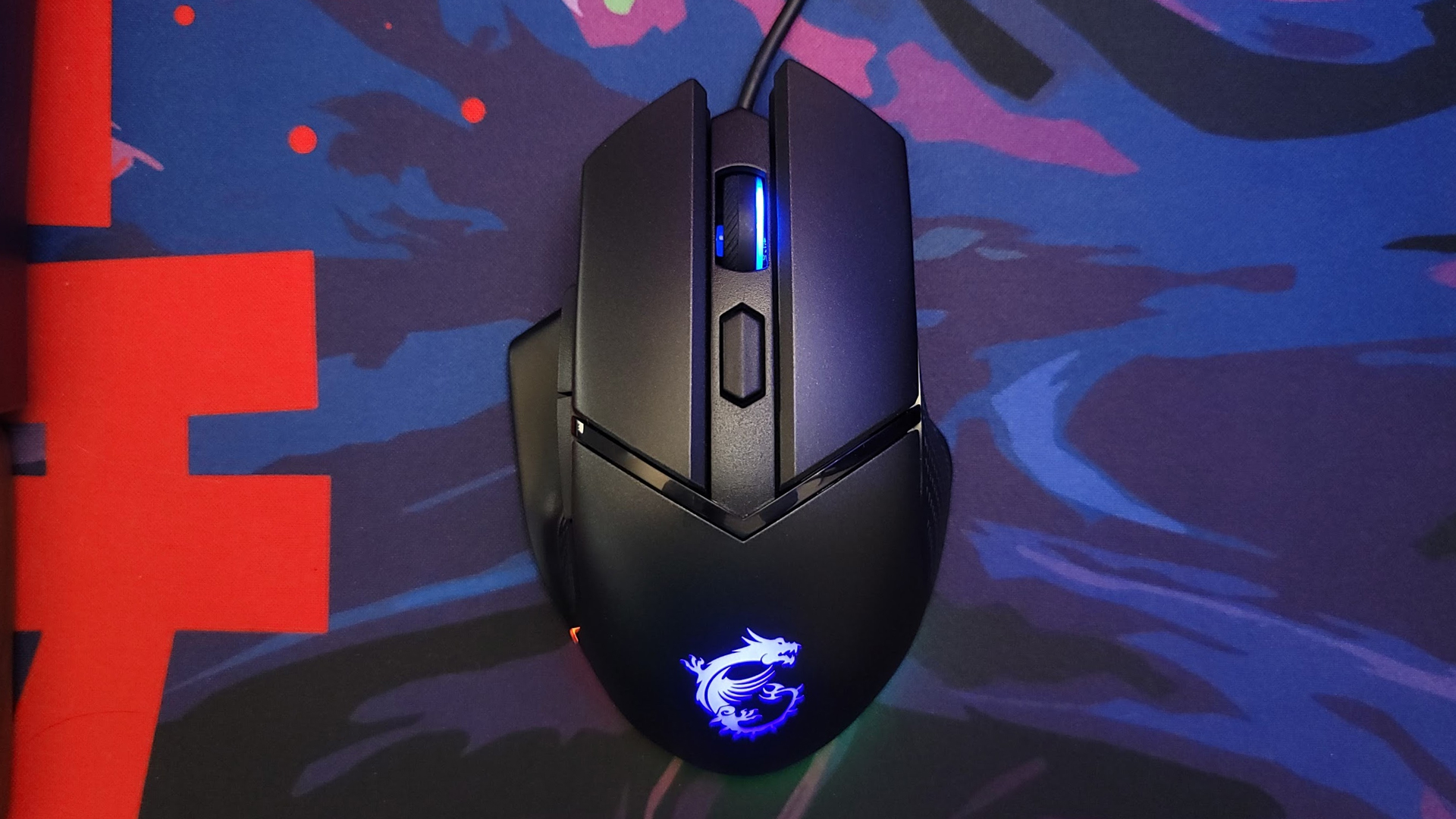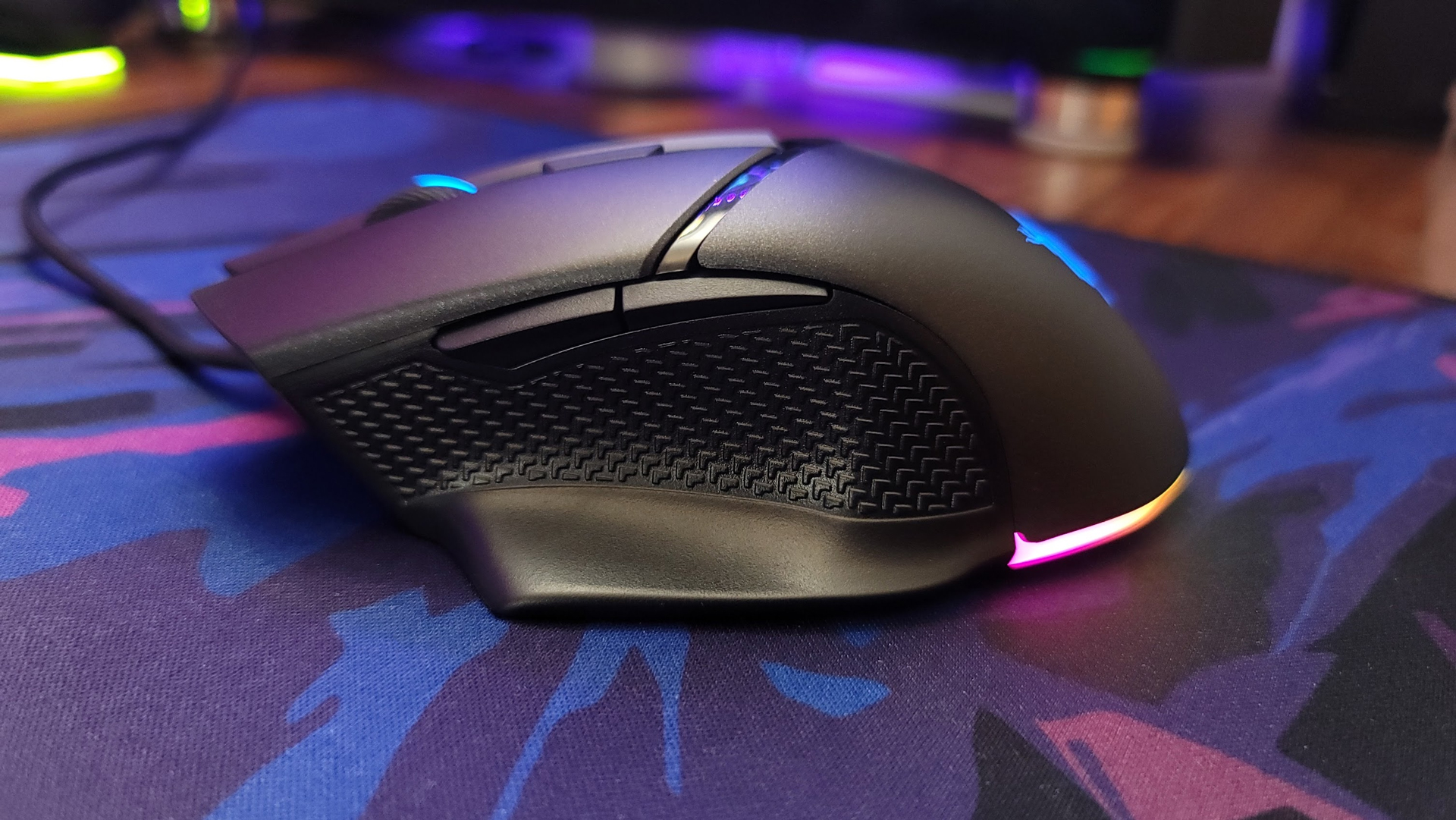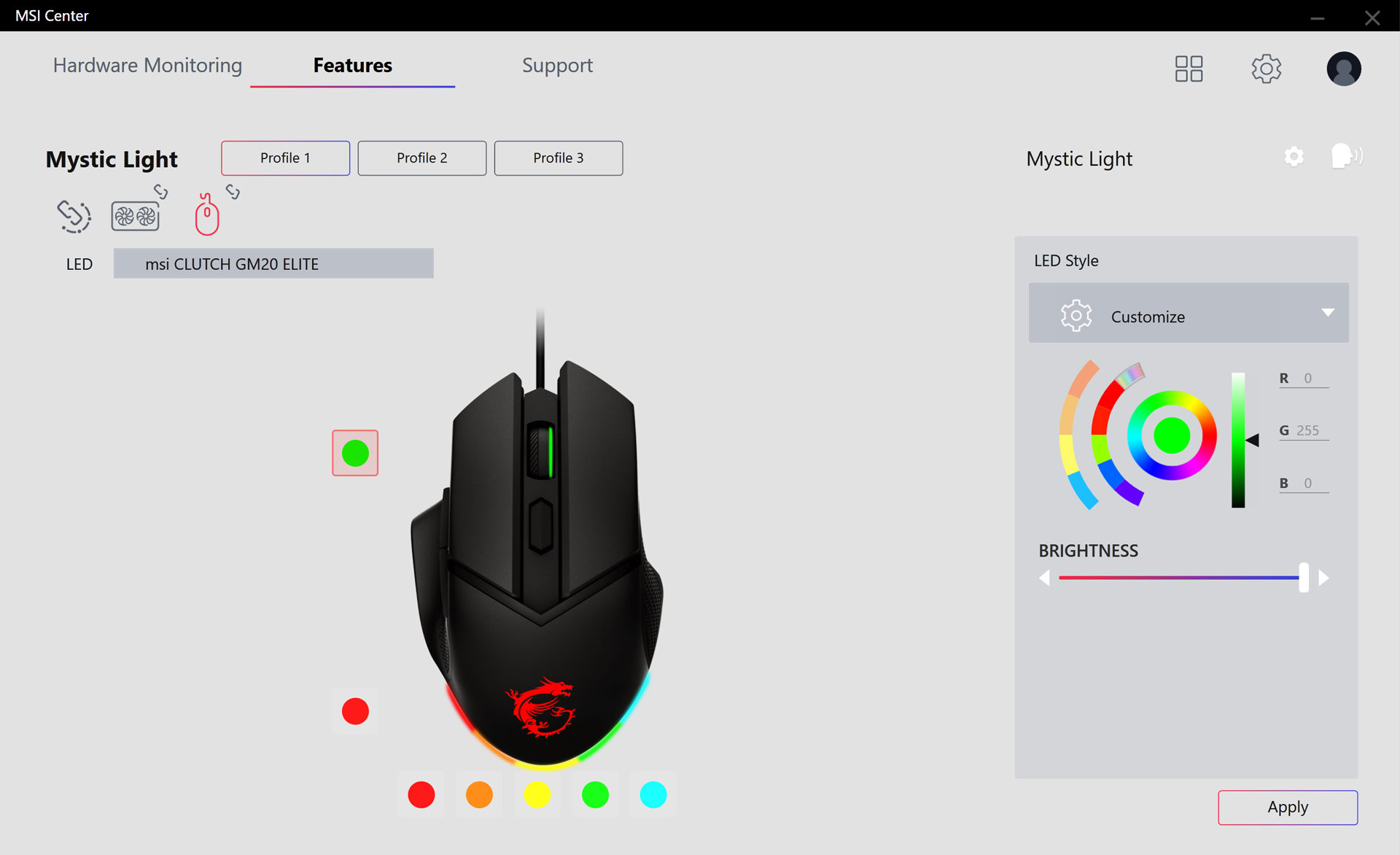Tom's Hardware Verdict
The MSI Clutch GM20 Elite is affordably priced for a mouse with 7 RGB zones and adjustable weight. Its shape promotes finger drag, however, and the middling specs make it a tough sell against the only slightly more expensive Logitech G502 Hero.
Pros
- +
+ Affordably priced
- +
+ Attractive RGB and adjustable weight
- +
+ Comfortable for palm or claw grips
- +
+ Flexible cable
Cons
- -
Shape promotes drag
- -
Mediocre software
- -
Middling switch specs
- -
Poor side grips
Why you can trust Tom's Hardware
With angular trigger buttons, a flared-out thumb rest, and a strikingly familiar shape, the MSI Clutch GM20 Elite is immediately reminiscent of the legendary Logitech G502. While both mice look similar at a glance, the GM20 Elite’s middling specs and general lack of features make it a competent but ultimately unremarkable option for gamers on a budget.
The Clutch GM20 Elite is eye-catching thanks to its two biggest features: customizable RGB lighting and an adjustable weight system. It features seven customizable lighting zones and eight software-free lighting presets to choose from, via shortcut keys. Popping the palm rest off the back reveals three chambers with removable weights, allowing you to tailor the weight between 0.22 and 0.24 pounds (98-109g). The mouse features six programmable buttons, Omron trigger switches, and a Pixart PAW-3309 optical sensor with a maximum DPI of 6400, including five levels of on-the-fly DPI cycling. These features allow the mouse to feel a step above the simpler budget options out there, but the GM20 Elite still won’t be winning any awards for being the best gaming mouse.
MSI Clutch GM20 Elite Specs
| Sensor Model | Pixart PAW-3309 optical sensor |
| Max Sensitivity | 6400 DPI |
| Polling Rates | 125/250/500/1000 Hz |
| Programmable Buttons | 6 |
| Button Durability | 20 Million Clicks |
| LED Zones | 7x RGB |
| Cable | 6.6 feet (2m) USB Type-A Cable |
| Connectivity | USB 2.0 |
| Measurements (LXWXH) | 5.1 x 3.28 x 1.62 inches (129.5 x 83.2 x 41.2 mm) |
| Weight | 0.22 - 0.24 pounds (98-109g) |
Design of MSI Clutch GM20 Elite
At only $33, the MSI Clutch GM20 Elite at first feels like a breath of fresh air. If left at first impressions, I would say this was a mouse that alignings itself with some of the greats, like the Logitech G502 Hero (the wireless variant of which is reviewed here) or the more recent Razer Basilisk V3. It looks great, with its bright RGB backlighting and desktop-illuminating underglow, and the adjustable weight system is a welcome feature that usually ships only with pricier mice.
First impressions are fleeting, however, and it quickly becomes apparent that this is ultimately a pretty simple mouse. From its shape to the internal specs, the Clutch GM20 Elite winds up feeling somewhat expensive for what it actually offers. The question of why anyone would choose this mouse really comes down to how much you like the shape, the adjustable weight and the presentation of its RGB.
The GM20 Elite features a total of six programmable buttons. The left and right triggers are separated and long, so you won’t have to worry about misclicks based on the position of your fingers. Between the two is a rubberized scroll wheel that’s textured on one side and smooth on the other where it approaches the embedded RGB ring. It feels strange under our finger, but doesn’t impact grip. Behind that is a DPI button that cycles through five preset sensitivity levels. Around the left side are the usual thumb buttons, which come pre-mapped to Forward and Back for web browsing. It’s a standard arrangement that should feel familiar to most users right off the bat.
Button placement is well-considered, and I didn’t have any trouble reaching them from the very first use. The thumb buttons and DPI selector are all raised, so finding the right key isn’t difficult without looking down. The scroll wheel is especially convenient, as it’s the perfect height and resistance to easily press without accidentally scrolling and changing weapons in the middle of a game.
The two triggers are powered by middle-of-the-line Omron switches. They have a satisfying click and tactility and require just enough pressure to resist accidental presses without feeling stiff. They feel good to use, but they’re not rated to be as durable as those on the G502 Hero. The GM20 Elite’s switches are rated for 20-million clicks each, whereas the G502 Hero’s come in at 50 million. This isn’t terrible but lands squarely in the middle of the road for switch life. Still, when even cheaper options like the Steelseries Rival 3 manage to triple that estimate for less money, it doesn’t look good for the GM20 Elite.
Get Tom's Hardware's best news and in-depth reviews, straight to your inbox.
The shape of the mouse is similar to Logitech’s G502, but there are some important differences anyone considering this as an alternative should know. Compared to Logitech’s mouse, the GM20 Elite’s palm rest is wider and slightly inclined to the left. This caused me to keep my hand further back on the mouse, encouraging a palm grip (though it’s still possible to claw). The G502’s symmetrical backend, on the other hand, encourages you to sit higher up on the mouse, more effectively supporting claw grip. Likewise, the G502’s right trigger button sharply tapers off while the GM20 Elite’s are identical, again encouraging the flatter lay of a palm grip style.
Likewise, the right side of the mouse sticks outward, forcing a separation between your clicking fingers and your ring and pinky. Claw grip, while possible, just isn’t as comfortable with the GM20 Elite. This shape also promotes drag from the ring and pinky fingers. If you’re looking for added control, this might be a good thing, but I found the decrease in speed to be a significant handicap compared to mice without this contour.
These are important distinctions because grip type can directly impact how responsive and accurate you are with a mouse. FPS gamers often prefer claw or fingertip mousing styles for the added twitch sensitivity under pressure. If you go into the GM20 Elite expecting it to be a “cheaper G502,” you’ll be in for a surprise, especially for first-person shooters.
The GM20 is a wired mouse, as you would expect from a gaming mouse at this price. The cable isn’t braided, but in this case that turns out to be an asset. Braided cables can look nice, but unless they’re braided with an extremely flexible fabric can feel stiff and lead to resistance when bunched up. The rubberized cable here looks a bit cheap but is flexible and doesn’t get in the way of movement. It’s actually one of the better cables I’ve used that doesn’t use paracord or some proprietary fabric for “wireless-like performance.”
The forward sides of the mouse are designed for control. Each side (ahead of the rear bulge) is tucked in and the entire area where you’ll be holding it is textured with a tiny arrow pattern to promote a better grip. This solution is reasonably effective, but I would have preferred to see rubberized grips, as what’s here can still feel somewhat slippery, especially with the adjustable weights.
The palm rest of the mouse is removable, which reveals three chambers that house the removable weights. On its own, the Clutch GM20 Elite weighs 0.22 pounds (98g). There are three weights (two 3-gram and one 5-gram) that can be mixed and match to increase the rodent’s mass up to 0.24 pounds (109g). This is heavier than many FPS mice, but substantially lighter than the G502. Fans of twitch shooters might find the combination of added drag and increased weight too much to bear, but I found it to be a nice middle ground between the new wave of ultralight mice and the older, heavier rodents I grew up with.
Flipping the mouse over, you’ll find some standard Teflon mouse feet (no white PTFE pads like on the only slightly more expensive Razer Viper Mini) and the optical sensor. The GM20 Elite is driven by a Pixart PAW-3309 optical sensor. It features a maximum DPI (dots per inch) of 6400, but MSI hasn’t offered many other details beyond that. In my research for this review, I wasn’t able to find any additional details on core specs such as max speed and acceleration. In fact, searching out the sensor pretty much only brings up listings for this mouse, so it doesn’t seem to be widely used.
One of the high points of the mouse is its RGB illumination. Both the palm rest and a ring along the mouse wheel light up with bright, saturated backlighting. Under the palm rest is a contoured diffusion strip that smooths out the glow of another five RGB LEDs and creates a nice underglow effect. These LEDs are customizable with more than 16 million colors inside MSI’s MSI Center software, but there are also eight preset lighting effects that can be cycled through by pressing the DPI button and the mouse wheel at the same time (nine if you include the stored custom lighting scheme). Holding the DPI button with the other keys allows you to adjust brightness, speed, direction, and color, which is an impressive level of customization for a gaming mouse.
When it comes to gaming, the GM20 Elite was serviceable, but it won’t be my go-to mouse anytime soon. The longer button on the right side was a perpetual distraction. Part of this is clearly due to personal taste in mouse shape, but an even bigger part is simply that the GM20 promotes awkward finger positioning that makes drag far more noticeable.
In my time with it, I put the mouse through its paces across nearly half a dozen games, but the first stop was 3D Aim Trainer, an online aim-training tool that provides an effective way to compare mice. I didn’t notice any issues with the sensor throughout this test, and the responsiveness of the mouse at 1600 DPI (my usual standard) was very good. I had to consciously remember to keep my pinky up throughout the tests, however, or else I was noticeably slower swapping between targets.
This was also an issue in first-person shooters like Call of Duty and Battlefield. I noticed myself unconsciously compensating for the mouse by gripping it harder and keeping my pinky locked to the side. The tension certainly made using the mouse less comfortable over time and left me with slight wrist fatigue after only thirty minutes. On the plus side, being forced to be more aware of my hand positioning did make me slightly more accurate in Aim Trainer, but the trade-off in speed just isn’t worth it against real players.
That said, mouse shape is a very personal thing. Gamers that excel with the greater control of palm grip may find these characteristics to be an asset. I use a hybrid grip style, half-palm and half-claw. For me, the GM20 Elite missed the mark in feel and speed.
On the plus side, the mouse offered a smooth glide on its Teflon feet. It doesn’t compete against higher-quality PTFE mouse feet in how smooth they feel traveling across a mouse pad, but in actual use the feet here were smooth enough to deliver a solid gaming experience. The flexibleness of the wire was a plus too, getting out of the way and letting me forget it was there.
With a maximum DPI of only 6400, this rodent won’t be winning any award for fastest mouse (and low DPI, high sensitivity gamers should look elsewhere), but I didn’t have any trouble holding my own in competitive shooters. Despite the lower max sensitivity rating, I found that even 6400 was far too sensitive for normal use, so leaving those ultra-high DPI ratings on the cutting room floor seems like a wise choice to keep costs in check.
If you need to swap on the fly, DPI can be cycled between five presets using the selector switch: 400, 800, 1600, 3200, and 6400. There’s no indicator light to tell which setting you’re on and since there’s only one selector button, you have to cycle through them all if you’d like to go down in speed. This limits its usefulness for snipers who need to quickly drop their sensitivity, but works well for most gaming.
The adjustable weight system is a nice add-on, but one I didn’t find much benefit in for my own play style. I tend to prefer a lighter mouse, so I left the weights out entirely after my first few days of testing. Still, for users who relish control, the ability to add that extra mass is a welcome addition and adds an extra layer of customization that most budget gaming mice don’t offer.
The buttons are also programmable within MSI Center, though with only six, the utility of that is naturally more limited. Fans of MOBAs and MMOs will likely find there to be too few buttons to map all of their skills and abilities, but for games with fewer keymaps, it’s nice to be able to tie your go-to skills to the thumb buttons for easier access.
The MSI Clutch GM20 Elite makes effective use of the company’s MSI Center software, but the available features are expectedly limited at this price. Controls for the mouse are broken into two areas: Mystic Light and Gaming Gear. Mystic Light offers a number of customization options for the RGB illumination. Gaming Gear is where you’ll program the buttons and adjust a limited amount of sensor options.

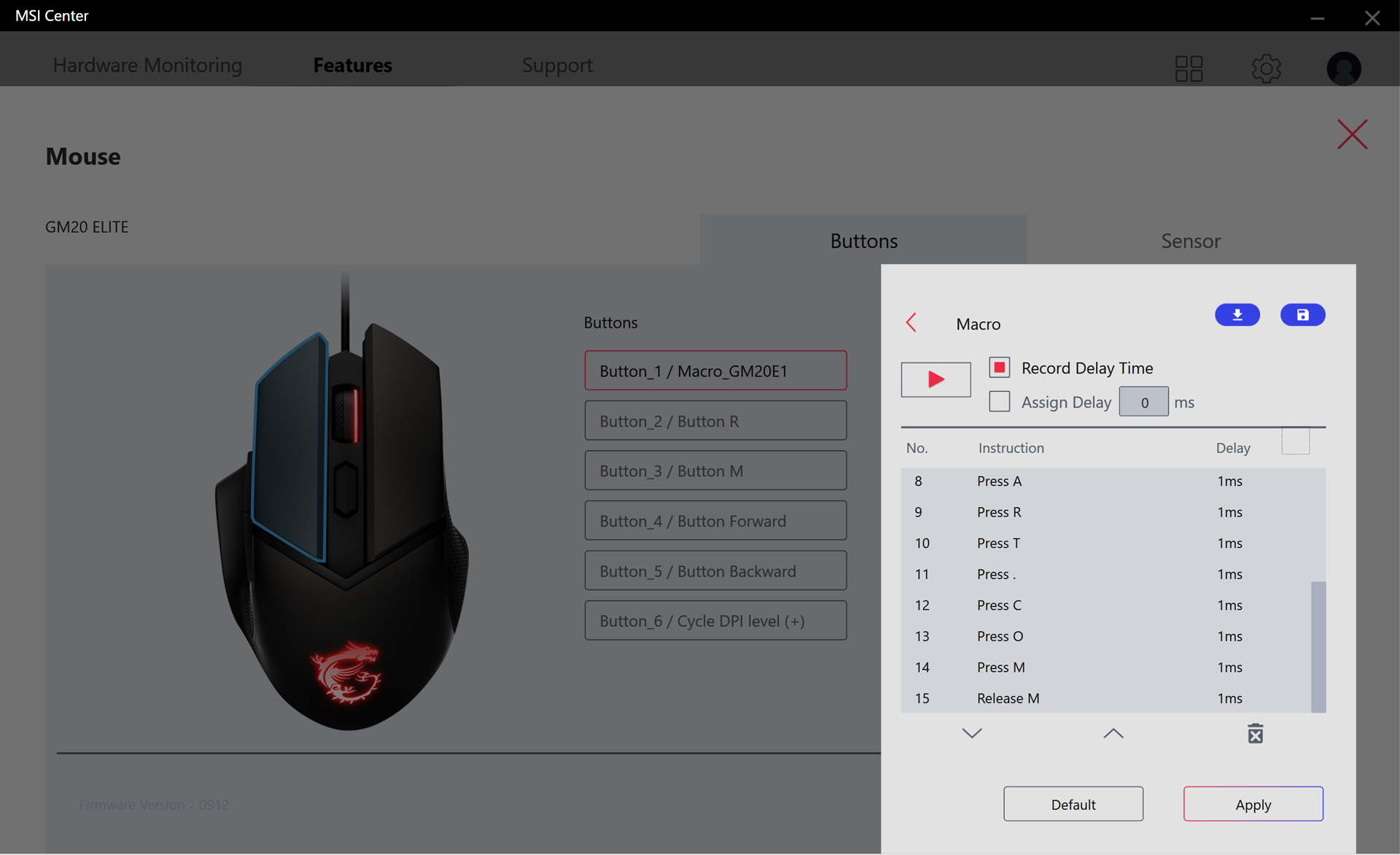
The Gaming Gear section is broken into two tabs: Buttons and Sensor. On the first of these screens, you can remap any of the GM20 Elite’s six inputs. Any of the buttons can be reprogrammed to another on the mouse, set to control multimedia, or set to trigger a macro. There’s no option to easily program a letter or number without simply plugging those commands into a macro and removing the delays, which is a pain but at least workable.
The Sensor tab allows you to customize your DPI and polling rate. The mouse comes set to 1000 Hz, which allows the computer to “poll” the position of the mouse one thousand times a second for a 1ms response time. This can be lowered to 500, 250, or even 125Hz if you prefer a slower polling rate. DPI, on the other hand, can be set anywhere between 200 and 6400 in 100 DPI increments, or typed in manually to the single digit. It’s not made clear in the software, but these settings do actually save to the mouse, and so can be moved between computers.
The Mystic Light section allows you to customize the eight preset lighting effects built into the mouse. Among these are the usual color cycling and rainbow wave options, but the mouse can also be set to flash, breathe, or light up every time the mouse is clicked. These latter options are all customizable for color, brightness, and speed. The final option allows you to manually set the color of each LED for a custom static lighting scheme. Though this Customize preset didn’t require the software again after it was saved to the mouse, color options wouldn’t travel between PCs and don’t appear to be stored on the mouse itself like the button remaps.
Bottom Line
The MSI Clutch GM20 Elite is a decent, if basic, mouse with a shape that’s bound to be divisive. The flare along the right-hand side created enough drag that it distracted me from my game until I unconsciously started to adapt around it. Clearly, it was a negative for me, but users who enjoy slower, more controlled experiences may actually find it to be a positive.
Still, the GM20 Elite has a hard time proving its value against the competition. The Logitech G502 Hero is only $44 and has a better sensor, better switches, more buttons with vastly improved programmability, an excellent freewheeling scroll wheel, and 18g of weight adjustment instead of 11. For $11 more, it’s a much better buy. Under the GM20 Elite is the Steelseries Rival 3, which has a great shape, eye-catching RGB, a high-resolution sensor, and vastly better rated switch durability for only $25. For only slightly more than the GM20 Elite, you can also get the Rival 3 Wireless and cut the cord entirely.
Ultimately, the MSI GM20 Elite is a decent but unremarkable gaming mouse that doesn’t quite earn its keep against the competition. If you prefer a slower gaming mouse and don’t mind the shape, it’s competent and has a couple of neat features to offer. But in the crowded field of sub-$50 cursor controllers, there are better options out there.

Chris is a regular contributor for Tom’s Hardware, covering mechanical keyboards, peripherals, and content creation gear.

